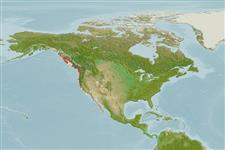Environment: milieu / climate zone / depth range / distribution range
Ecologia
marino demersale; distribuzione batimetrica 2 - 38 m (Ref. 2850). Temperate; 58°N - 32°N, 138°W - 117°W
Eastern Pacific: Baranof Island, southeastern Alaska to Point Lobos, central California, USA.
Size / Peso / Age
Maturity: Lm ? range ? - ? cm
Max length : 15.0 cm TL maschio/sesso non determinato; (Ref. 2850)
Short description
Chiavi di identificazione | Morfologia | Morfometria
Spine dorsali (totale) : 17 - 18; Raggi dorsali molli (totale) : 15 - 17; Spine anali: 0; Raggi anali molli: 22 - 24. Caudal fin rounded (Ref. 6885). Color olive green and generously marked with red; six or seven dark saddles across back and another series of dark spots along midside; oblique dark bands across dorsal and pectoral fins; wide dark, and narrow light sinuous bands on head (Ref. 6885).
Occurs in intertidal areas and to 38 m depth, in rocky areas and kelp (Ref. 2850). Frequently hangs vertically on rock faces (Ref. 2850). Active and highly territorial during the breeding season (Ref. 6885).
Life cycle and mating behavior
Maturities | Riproduzione | Spawnings | Egg(s) | Fecundities | Larve
Eschmeyer, W.N., E.S. Herald and H. Hammann, 1983. A field guide to Pacific coast fishes of North America. Boston (MA, USA): Houghton Mifflin Company. xii+336 p. (Ref. 2850)
IUCN Red List Status (Ref. 130435)
Threat to humans
Harmless
Human uses
Pesca: commerciale; Acquario: Acquari pubblici
Strumenti
Special reports
Download XML
Fonti Internet
Estimates based on models
Preferred temperature (Ref.
123201): 8.9 - 12, mean 10.3 °C (based on 50 cells).
Phylogenetic diversity index (Ref.
82804): PD
50 = 1.0000 [Uniqueness, from 0.5 = low to 2.0 = high].
Bayesian length-weight: a=0.00389 (0.00180 - 0.00842), b=3.12 (2.94 - 3.30), in cm total length, based on all LWR estimates for this body shape (Ref.
93245).
Trophic level (Ref.
69278): 3.4 ±0.50 se; based on food items.
Resilienza (Ref.
120179): Alto, tempo minimo di raddoppiamento della popolazione meno di 15 mesi (Preliminary K or Fecundity.).
Fishing Vulnerability (Ref.
59153): Low vulnerability (10 of 100).
Nutrients (Ref.
124155): Calcium = 103 [39, 235] mg/100g; Iron = 0.411 [0.189, 0.947] mg/100g; Protein = 17.3 [15.1, 19.5] %; Omega3 = 0.586 [0.235, 1.630] g/100g; Selenium = 9.51 [3.99, 23.71] μg/100g; VitaminA = 30.1 [8.1, 103.8] μg/100g; Zinc = 0.865 [0.546, 1.529] mg/100g (wet weight);
